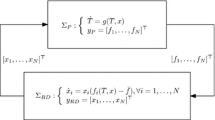Abstract
We consider the problem of optimal stabilization and control of populations which follow the Leslie model dynamics, within state space and control systems theory and methodology. Various types of culling strategies are formulated and introduced into the Leslie model as control inputs, and their effect on global asymptotic stability is investigated. Our new approach provides answers to several unexplored problems. We show that in general it is possible to achieve a desired stable equilibrium population level, through the design of a class ofshifted-proportional stabilizing culling policies. Further, we formulate general non-linear constrained opitmization problems, for obtaining the cost-optimal policy among this generally infinite class of such stabilizing policies. The theoretical findings are illustrated through the solution of the problem over an infinite planning horizon for a numerical example. A comparative study of the costs and dynamic effects of various culling strategies also supports the mathematical results.
Similar content being viewed by others
References
Baranov, T. I. 1918. On the question of the biological basis of fisheries.Nauk. Issledov. Iktol. Ins. Izv. 1, 81–128.
Barlow, J. and P. Boveng. 1991. Modelling age specific mortality for marine mammal populations.Marine Mammal Sci. 7, 50–65.
Beddington, J. R. 1975. Economic and ecological analysis of red deer harvesting in Scotland.J. Env. Manag. 3, 91–103.
Beddington, J. R. and D. B. Taylor. 1973. Optimum age specific harvesting of a population.Biometrics 29, 801–809.
Cattan, P. E. and A. A. Glade. 1989. Management of the Vicuna in Chile: use of a matrix model to assess harvest rates.Biological Conservation 49, 131–140.
Cull, P. 1988. Stability of discrete one-dimensional population models.Bull. Math. Biol. 50, 67–75.
Doubleday, W. G. 1975. Harvesting in matrix population models.Biometrics 31, 189–200.
Flipse, E. and E. Veling. 1984. An application of the Leslie matrix model to the population dynamics of the hooded sealCystophora Cristata Erxleben.Ecol. Model. 24, 43–59.
Kwakernaak, H. and R. Sivan. 1972.Linear Optimal Control Systems. New York: Wiley.
Lefkovitch, L. P. 1967. A theoretical evaluation of population growth after removing some individuals from some age groups.Bull. Env. Res. 57, 437–445.
Leslie, P. H. 1945. On the use of matrices in certain population mathematics.Biometrika 33, 183–212.
Leslie, P. H. 1948. Some further notes on the use of matrices in population mathematics.Biometrika 35, 213–245.
Lewis, E. G. 1942. On the generation and growth of a population.Sankhya 6, 93–96.
Maghsoodi, Y. 1989. Design and computation of near-optimal stable observers for bilinear systems.IEEE Proc. 136, Pt. D, 3, 127–132.
Maguire, L. A. 1986. Using decision analysis to manage endangered species populations.J. Env. Manag. 22, 345–360.
Mcdonald, J. J. 1981. Deer harvesting. InCase Studies in Mathematical Modelling. J. J. Mcdonald and D. J. G. James (Eds), pp. 27–54. Cheltenham: S. Thornes.
Mendelssohn, R. 1976. Optimization problems associated with a Leslie matrix.The Amer. Naturalist 110, 339–345.
Minc, H. 1988.Non-negative Matrices. New York: Wiley.
Ogata, K. 1987.Discrete-Time Control Systems. New Jersey: Prentice-Hall.
Plant, R. E. 1986. A method for computing the elements of the Leslie matrix.Biometrics 42, 933–939.
Schwarz, R. J. and B. Friedland. 1965.Linear Systems. New York: McGraw-Hill.
Silva, J. A. L. and T. G. Hallam. 1993. Effects of delay, truncations and density dependence in reproduction schedules on stability of nonlinear Leslie matrix models.J. Math. Biol. 31, 367–395.
Sondgerath, D. and O. Richter. 1990. An extension of the Leslie matrix model for describing population dynamics of species with several development stages.Biometrics 46, 595–607.
Sykes, Z. M. 1969. On discrete stable population theory.Biometrics 25, 285–293.
Usher, M. B. 1972. Developments in Leslie matrix model. InMathematical Models in Ecology. J. N. R. Jeffers (Ed.), pp. 29–60. Oxford: Blackwell.
Usher, M. B. 1976. Extensions to models used in renewable resource management which incorporate an arbitrary structure.J. Env. Manag. 4, 123–140.
Williamson, M. H. 1959. Some extensions of the use of matrices in population theory.Bull. math. Biophys. 21, 13–17.
Williamson, M. H. 1967. Introducing students to the concepts of population dynamics. InThe Teaching of Ecology. J. M. Lambert (Ed.), pp. 169–175. Oxford: Blackwell.
Williamson, M. H. 1972.The Analysis of Biological Populations. London: Edward Arnold.
Author information
Authors and Affiliations
Rights and permissions
About this article
Cite this article
Maghsoodi, Y., Grist, E.P.M. Optimal population stabilization and control using the Leslie matrix model. Bltn Mathcal Biology 57, 381–399 (1995). https://doi.org/10.1007/BF02460631
Received:
Accepted:
Issue Date:
DOI: https://doi.org/10.1007/BF02460631




